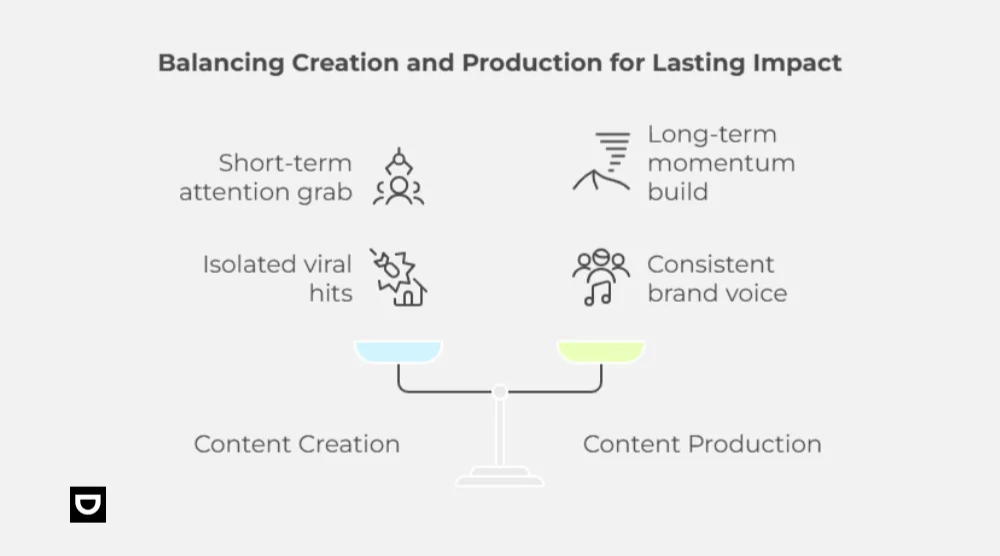Content Creation vs Content Production: Key Differences Explained
Have you ever wondered why some content just clicks with people, while other content barely gets noticed? It might have less to do with what you create and more about how you bring it to life.
The magic happens when two important parts work together, but most people don’t realize what those parts really are. Keep reading to discover the secret behind the content that not only grabs attention but also keeps your audience coming back for more.
Key takeaways
- Understand the key differences between content creation and content production.
- Why understanding the difference between content creation and content production matters.
- See how content creation and production work together in marketing.
- Exploring the different skills needed for content creation and production.
- Learn how to find the right balance between creativity and consistency.
What is content creation, and how does it differ from content production?
When we talk about content creation, we’re referring to the imaginative and tactical process of crafting individual assets, blog posts, videos, and social media posts.
Content Creation

Content creation is where writers, designers, and creators bring their creative ideas to life. Content creation is focused solely on producing deliverables, that is bringing your ideas to life through:
- Blog posts
- Social media posts
- Graphics
- Videos.
This is the “hands-on execution phase” of your content strategy.
Content Production

On the other hand, content production is the operational engine that turns your creative ideas into a polished, ready-to-publish reality. Content production covers everything from setting up workflows, managing deadlines, running editing cycles, scheduling posts, and coordinating distribution across multiple channels.
Simply put, content production is the backend that makes your creation scalable and repeatable, often supported by content marketing automation tools that streamline from:
- Setting up your workflows
- Managing deadlines
- Running your editing cycles
- Scheduling of your posts
- Coordinating distribution.
So, while content creation focuses on what gets made, content production is about how it gets made, refined, and delivered effectively. Together, they form a cycle: content creation fuels originality, while content production ensures consistency and scalability.
Try managing your entire content process in one smooth flow, from creation to publishing, and see how much easier it gets with Dumpling AI.
Start for FreeWhy is understanding the difference between content creation and content production important?

If you only think in terms of content creation, you might end up with a few viral posts here and there that may grab attention for a short period of time, which is why you need a good strategic alignment to turn those efforts into long-term impact.
This is where the idea of content production comes in, often supported by content automation platforms, to give you consistency and direction while aligning your creation with broader marketing objectives and audience needs. Instead of isolated hits, you build momentum over time and create a brand voice people can recognize and trust.
The difference is crucial: content creation fuels your ideas, production builds and realizes your ideas, and strategy steers the direction in which your content gets seen. When all three are understood and applied together, your content shouldn’t just exist; it should drive results and leave a lasting impact.
How Content Creation and Production Work Hand-in-Hand in Marketing
In marketing, content creation and production are like two sides of the same coin, where content creation is where the ideas are born: writing the blog, designing the graphic, or filming the video, while content production is what ensures that those ideas actually make it into the world in a polished, consistent, and timely way.
Think of it this way: you might create a brilliant blog article, but without production steps like editing, SEO optimization, scheduling, and publishing, it could sit unpublished or reach only a fraction of your audience.
Meanwhile, when the two work together, marketing becomes more than just bursts of creativity, it turns into a steady and strategic display of your creativity that builds awareness, engagement, and long-term trust with your audience.
The Skills Behind Content Creation vs. Content Production
While both of them overlap, the skills needed for each are pretty different.
Content Creation
This is where creativity is king, and include having skills like:
- Writing with personality
- Designing eye-catching visuals that pop & grab attention
- Storytelling that connects with your audience
- Editing videos that flow and captivates
- Capturing the perfect photo.
Content creation is all about making something original that feels fresh and authentic.
Content Production
The focus here shifts to structure and performance, and this leans more to having operational skills, such as:
- Project management
- Editing & proofing
- SEO optimization
- Analytics & reporting
- Mastery of publishing tools.
In short, content production is about efficiency, that is making sure your content isn’t just made, but optimized, scalable, and capable of performing well across multiple channels.
Simply put: Creation is about imagination, while production is about organization. Whether you’re part of a strong marketing team or a solo creator handling both, you need both to succeed. Great content not only looks good but also performs because it’s made with purpose
Finding the Right Balance Between Creation and Production
One of the trickiest parts of marketing is finding the right balance between being creative and being consistent. If you lean heavily on:
- Too much creation → It leads to scattered ideas, unfinished drafts, inconsistent posting.
- Too much production → It leads to polished but robotic content with no personality.
The secret is to simply do both, with a system like:
- Editorial calendars
- Content workflows
- Automation tools (like Dumpling AI) to help you take care of repetitive tasks, so you can have the freedom to focus on the human side of content, which is storytelling, experimenting with new formats, and connecting emotionally with the audience’s needs.
When creation and production are balanced, the results compound. Every idea gets its chance to shine, every piece of content supports a bigger story, and every effort contributes to leaving a long-term impact. It’s not about choosing one over the other, but about letting both do what they do best.
Final thoughts
In summary:
- Content creation = is the creative force that sparks and brings new ideas to life
- Content production = is the operational backbone that ensures those ideas get seen consistently to the right audience.
Understanding the key differences between the two allows your marketing to be both imaginative and scalable. This is where tools like Dumpling AI come in to make a real difference.
By streamlining everything from ideation to supporting production workflows, Dumpling AI helps save time on repetitive tasks. Their content marketing automation features make it easier to scale creativity without losing structure.
So, why wait? Bring creativity and structure together and start creating smarter today.
Start nowFAQs
What is the primary distinction between content creation and content production?
Content creation is about generating creative assets (writing, design), whereas content production involves coordination, editing, distribution, and optimization of those assets.
Can content creation happen without production?
Yes, but it often leads to inefficiencies, as your content may lack consistency, reach, or strategic alignment if not properly produced and optimized.
Is ‘content development’ the same as content production?
“Content development” often refers to the broader strategy (planning, distribution, measurement), overlapping with production but sometimes more strategic in scope.
Why does production include SEO practices?
Because production ensures content performs—SEO steps like transcripts or metadata improve search visibility and accessibility, enhancing impact
How can tools like Dumpling AI fit into this workflow?
Dumpling AI can streamline creation (by generating drafts, ideas) while integrating with production systems to manage edits, approvals, and scheduling, bridging the creative and operational gap smoothly.





